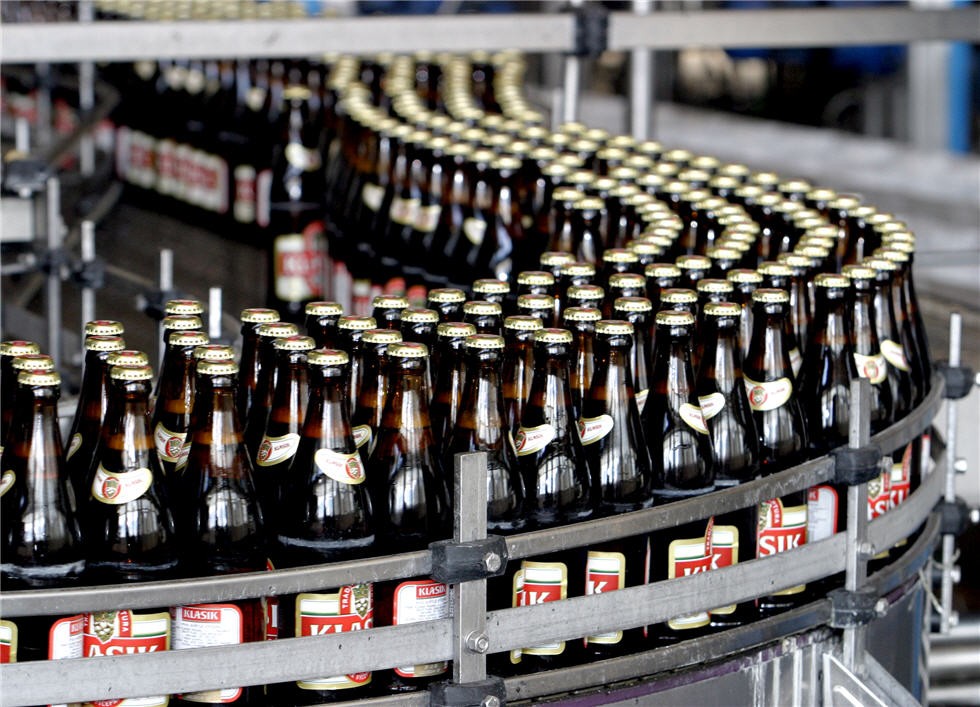- 09/28
- 2021
-
QQ扫一扫

-
Vision小助手
(CMVU)

- 报告来源:北京华通人商用信息有限公司
时间:2021/09/28 - Report source: China visual network
Time: 2021/09/28
-
联系电话:010-62650570-806
联系人:徐小姐
-
Contact phone: 010-62650570-806
Contact person: miss xu
行业销售收入保持稳定增长态势
2004-2008 年间,中国啤酒制造行业销售收入增长保持稳定,销售收入从632.0 亿元增长至1099.8 亿元,年均复合增长率达到14.6%。市场需求的高涨是行业发展的最大动力,人均GDP 和居民可支配收入的持续增长催生啤酒行业快速发展。收入的增长触发居民消费升级,对啤酒等快速消费品的需求大幅上涨。
2009 年前11 个月,啤酒制造行业实现销售收入1143.2 亿元,同比增长10.4%,继续保持稳定的增长。随着中国居民消费能力的提升以及消费习惯的变化、企业产品结构调整等方面影响,也是推动啤酒行业收入保持稳定增长的重要原因。
中国成为世界第一大啤酒消费国
2002 年,中国啤酒产销量首次超过美国,成为世界第一啤酒生产和消费大国。此后,中国市场开始引领世界啤酒行业增长。目前,中国已经连续八年成为世界最大的啤酒消费国。2009 年,中国啤酒销量达到4281.4 万千升,同比增长5.6%。中国消费市场广阔,啤酒消费主要是国内市场,出口占比很低。
行业进入成熟期
国内啤酒行业经历了起步、发展、快速增长等多个阶段,现在已经进入行业成熟期。从啤酒产量来看,2004-2009 年,啤酒产量从2910.1 万千升上升至4236.4 万千升,年均复合增长率为7.8%。行业进入成熟期的特点主要有,产业增长速度放缓、行业内企业并购加剧,竞争不断增加等。
瓶装啤酒出厂价格呈现下降趋势
从瓶装啤酒出厂价格指数走势看,2008 年瓶装啤酒出厂价格指数在高位运行,2009 年4 月时瓶装啤酒出厂价格指数也出现大幅回落,环比下降3.8 个百分点。从2009 年4 月至今,瓶装啤酒出厂价格保持平稳运行,波动较小。
以地产地销为主
由于受到运输半径和新鲜程度的限制,啤酒生产一般以地产地销为主。现阶段啤酒厂商越来越倾向于“地产地销”模式,通过在销售区域兼并啤酒生产厂或新建生产厂等方式,来占领市场。如燕京啤酒在全国拥有生产企业22 个,遍布11 个省,华润雪花啤酒在中国经营近70 家啤酒厂等等。产品销售距离虽然不限制在300 公里以内的范围内,但是相对来说运输距离也大大缩短了。
行业内竞争异常激烈
中国啤酒市场竞争格局存在区域化、品牌分散、平均消费量低等问题,但是随着国内外啤酒企业巨头在国内市场的扩张,行业竞争加剧,啤酒业出现大范围整合,行业集中度得到提高。经过多年发展,中国啤酒企业形成三大阵营。第一阵营包括华润雪花、青岛啤酒和燕京啤酒。三大企业的全国性品牌知名度很高,在全国市场形成三足鼎立之势。第二阵营主要包括重庆啤酒、哈尔滨啤酒、珠江啤酒等强势地方品牌,这些企业在当地市场及周边市场知名度和市场占有率很高。第三阵营为规模较小的地方企业。
随着全国三大啤酒巨头的扩张和强势地方企业的发展,地方小企业的生存空间将会被挤压。而内外资大型企业的兼并和扩产将会继续,市场集中度有望继续提升。
啤酒产业向高端化延伸
中国啤酒工业已经进入成熟发展阶段,啤酒产品品牌和质量趋向成熟。啤酒高端化是市场的发展趋势,特别是中国目前高端啤酒市场,以百威、喜力、嘉士伯等欧美强势品牌为代表的外国高端啤酒。中国啤酒高档产品生产规模小,产量很低。
国内啤酒企业加快步伐进入高端市场竞争,2009 年,青岛啤酒推出国内第一款高端啤酒奥古特,成为啤酒市场的一个亮点。随着国内啤酒企业增加高端市场的投入,未来高端市场将成为啤酒企业竞争主战场。
如您需要查看更多详细信息,请直接下载。
Abstract
Industry sales revenue maintained a steady growth trend
From 2004 to 2008, the sales revenue of China's beer manufacturing industry maintained a steady growth, increasing from 63.02 billion yuan to 109.98 billion yuan, with an annual compound growth rate of 14.6%. The upsurge of market demand is the biggest driving force for the development of the industry. The continuous growth of per capita GDP and residents' disposable income accelerates the rapid development of the beer industry. Income growth triggered the upgrading of residents' consumption, and the demand for beer and other fast-moving consumer goods rose sharply.
In the first 11 months of 2009, the sales revenue of beer manufacturing industry reached 114.32 billion yuan, with a year-on-year growth of 10.4%, which continued to maintain a stable growth. With the improvement of Chinese residents' consumption power, the change of consumption habits, and the adjustment of enterprise product structure, it is also an important reason to promote the stable growth of beer industry income.
China has become the world's largest beer consumer
In 2002, China's beer production and sales exceeded that of the United States for the first time, becoming the world's largest beer production and consumption country. Since then, the Chinese market has begun to lead the growth of the world beer industry. At present, China has been the world's largest beer consumer for eight consecutive years. In 2009, beer sales in China reached 42.814 million kiloliters, up 5.6 percent year on year. China has a vast consumer market, and beer consumption is mainly domestic market, with a very low proportion of export.
The industry has entered a mature period
The domestic beer industry has experienced several stages, such as starting, development and rapid growth, and now it has entered the mature stage of the industry. In terms of beer production, from 2004 to 2009, beer production increased from 29.101 million kL to 42.364 million kL, with a CAGR of 7.8%. The characteristics of the industry entering the mature period mainly include the slowdown of the growth rate of the industry, the intensification of the mergers and acquisitions of enterprises in the industry, and the increasing competition.
Bottled beer ex-factory prices showed a downward trend
According to the trend of the ex-factory price index of bottled beer, in 2008, the ex-factory price index of bottled beer was running at a high level. In April 2009, the ex-factory price index of bottled beer also showed a sharp decline, dropping by 3.8 percentage points month-on-month. Since April 2009, the ex-factory price of bottled beer has maintained a stable operation with little fluctuation.
Sales to the origin of the main
Due to the limitation of transportation radius and freshness degree, beer production is generally ba sed on local origin. At the present stage, beer manufacturers are more and more inclined to "local sales" mode, and occupy the market by means of merging beer factories or building new production plants in the sales area. For example, Yanjing Brewery has 22 production enterprises in 11 provinces, and China Resources Snow Brewery operates nearly 70 breweries in China. Although the product sales distance is not restricted within the range of 300 kilometers, but relatively speaking the transportation distance is also greatly shortened.
Competition in the industry is fierce
The competition pattern of China's beer market has problems such as regionalization, dispersed brands and low average consumption. However, with the expansion of domestic and foreign beer giants in the domestic market, the industry competition has intensified, the beer industry has appeared large-scale integration, and the industry concentration has been improved. After years of development, Chinese beer enterprises form three camps. The first group includes China Resources Snow, Tsingtao and Yanjing. The national brands of the three major enterprises are very well known, forming a three-legged position in the national market. The second camp mainly includes Chongqing Beer, Harbin Beer, Pearl River Beer and other strong local brands, which have high visibility and market share in the local market and surrounding markets. The third group is smaller local firms.
With the expansion of the country's big three beer giants and the development of powerful local companies, the living space of local small businesses will be squeezed. The merger and expansion of large domestic and foreign enterprises will continue, and the market concentration is expected to continue to improve.
The beer industry is expanding upmarket
China's beer industry has entered a mature development stage, the brand and quality of beer products tend to mature. High-end beer is the development trend of the market, especially the current high-end beer market in China, represented by Budweiser, Heineken, Carlsberg and other powerful European and American brands. The production scale of high-grade beer products in China is small and the output is very low.
Domestic beer enterprises accelerate their pace to enter the high-end market competition. In 2009, Tsingtao Beer launched the first high-end beer in China, Augute, which became a bright spot in the beer market. With the increase of domestic beer enterprises' investment in high-end market, the high-end market will become the main competition battlefield of beer enterprises in the future.
If you need to view more detailed information, please download directly.
摘要..............................................................................................1
1 行业定义........................................................................................6
1.1 定义..........................................................................................6
1.2 主要产品......................................................................................6
1.3 产业链........................................................................................7
1.3.1 上游行业....................................................................................7
1.3.2 下游行业....................................................................................8
1.4 竞争行业......................................................................................8
2 行业成长........................................................................................9
2.1 行业发展......................................................................................9
2.2 生命周期......................................................................................12
2.3 行业波动性....................................................................................12
3 市场特征........................................................................................13
3.1 市场概述......................................................................................13
3.1.1 销售规模....................................................................................13
3.1.2 生产规模....................................................................................14
3.1.3 产品结构....................................................................................14
3.1.4 产品价格....................................................................................15
3.1.5 渠道特点....................................................................................16
3.2 产品细分市场..................................................................................18
3.3 地区市场......................................................................................19
3.4 终端市场......................................................................................20
3.4.1 终端市场....................................................................................20
3.4.2 销售终端....................................................................................21
4 对外贸易........................................................................................23
4.1 全球市场环境..................................................................................23
4.2 出口..........................................................................................24
4.3 进口..........................................................................................26
5 市场竞争........................................................................................28
5.1 竞争维度......................................................................................28
5.2 竞争格局......................................................................................29
5.3 行业集中度....................................................................................30
5.4 成本结构......................................................................................32
5.5 进入壁垒......................................................................................33
6 重点企业........................................................................................34
6.1 重点企业分析..................................................................................34
6.1.1 华润雪花啤酒有限公司........................................................................34
6.1.2 北京燕京啤酒有限公司........................................................................37
6.1.3 青岛啤酒股份有限公司........................................................................39
6.1.4 百威英博啤酒集团............................................................................41
6.1.5 重庆啤酒集团................................................................................43
6.2 其他重点企业..................................................................................45
6.2.1 金星啤酒集团有限公司........................................................................45
6.2.2 珠江啤酒集团有限公司........................................................................46
6.2.3 金威啤酒集团................................................................................47
6.2.4 江苏大富豪啤酒有限公司......................................................................48
6.2.5 河北蓝贝酒业集团有限公司....................................................................49
7 经营环境........................................................................................50
7.1 政策法规......................................................................................50
7.2 行业扶持......................................................................................51
7.3 技术/体系.....................................................................................52
8 市场预测........................................................................................53
8.1 关键影响因素..................................................................................53
8.2 市场发展预测..................................................................................55
9 数据汇总........................................................................................58
9.1 行业核心数据(2003-2008).....................................................................58
9.2 行业信息源....................................................................................59
10 指标解释.......................................................................................60
- 上一条:中国工业自动控制系统装置行业分析报告
- 下一条:中国电子计算机行业分析报告
